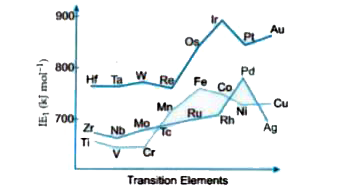(a) Write balanced equations to represent what happens when
(i) Cu2+ is treated with KI.
(ii) Acidified potassium dichromate solution is reacted with iron (II) solution (ionic equation).
(b) (i) The figure given below illustrates the first ionisation enthalpies of first, second and third series of transition elements. Answer the questions that follow :

Which series amongst the first, second and third series of transition elements have the highest first ionisation enthalpy and why ?
(ii) Separation of lanthanoid elements is difficult. Explain.
(iii) Sm2+,Eu2+ and Yb2+ ions in solution are good reducing agents but an aqueous solution of Ce4+ is a good oxidising agent. Why?
Text Solution
(a) (i) 2Cu++4I−→Cu2I2(s)+I2
In this case Cu2+ oxidises I− to I2.
(ii) Cr2O2−7+14H++6Fe2+→2Cr3++6Fe++7H2O
(b) (i) The third series of transition elements have the highest first ionisation enthalpy. This is due to weak screening effect of f-orbitals and higher nuclear charge of the third series of transition elements.
(ii) Separation of lanthanoid elements is difficult because of the identical ionic radii of these elements.
(iii) Lanthanoids show +3 oxidation state predominantly. That is why Sm2+,Eu2+ and Yb2+ act as reducing agents, they are themselves oxidised to Sm3+,Eu3+ and Yb3+ respectively which is the preferred oxidation state of lanthanoids. Ce4+ is a strong oxidising agent and reverts to +3 state. The E∘ value for Ce4+/Ce3+ is 1.74 V.
|
Topper's Solved these Questions
- THE D-AND F-BLOCK ELEMENTS BOOK - U-LIKE SERIESCHAPTER - THE D-AND F-BLOCK ELEMENTS EXERCISE - SELF ASSESSMENT TEST (SECTION A ) MULTIPLE CHOICE QUESTIONS (CHOOSE THE CORRECT OPTION)
7 Videos
- THE D-AND F-BLOCK ELEMENTS BOOK - U-LIKE SERIESCHAPTER - THE D-AND F-BLOCK ELEMENTS EXERCISE - LONG ANSWER QUESTIONS-I (3 marks each)
22 Videos
- SURFACE CHEMISTRYBOOK - U-LIKE SERIESCHAPTER - SURFACE CHEMISTRYEXERCISE - SELF ASSESSMENT TEST ( SECTION A)
7 Videos
- THE P-BLOCK ELEMENTS BOOK - U-LIKE SERIESCHAPTER - THE P-BLOCK ELEMENTS EXERCISE - SELF ASSESSMENT TEST ( SECTION A)
7 Videos
Similar Questions
Knowledge Check
The first elements of first, second and third transition series respectively are
AZn, Cd, HgBSc, Y, LaCCu, Ag, AuDSc, Y, LaThe first ionisation energies of the elements of the first transition series (Ti→Cu)
Aincreases as the atomic number increasesBdecreases as the atomic number invreasesCdo not show any change as the addition of electrons takes place in the inner (n- 1) d orbitalsDincreases from Ti to Mn and then decreases from Mn to Cu.The first ionisation energies of the elements of the first transition series (Ti→Cu)
AIncreases as the atomic number increasesBDecreases as the atomic number increasesCDo not show any change as the addition of electrons takes place in the inner (n−i) d-orbitals.DIncreases from Ti to Mn and then decreases from Mn to Cu.
How would you account for the irregular variation of ionization enthalpies (first and second) in the first series of the transition elements ?
View SolutionHow would you account for the irregular of ionisation enthalpies (first) in the first series of the transition elements?
View SolutionThe first ionisation energies of the elements of the transition series.
View SolutionName the third and fourth transition elements of first transition series.
View SolutionThe first ionisation energies of the elements of the transition series.
View Solution
